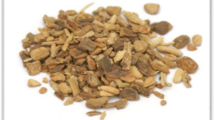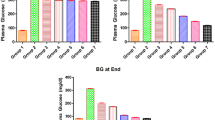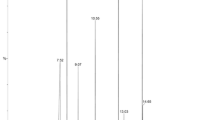Abstract
We evaluated the hypoglycemic and antioxidant effects of the total alkaloids of leaves and twigs of Catharanthus roseus Linn. (CTA) in streptozotocin (STZ)-induced diabetic rats. The hypoglycemic effect was measured by blood glucose and plasma insulin level. Oxidative stress was measured in heart, liver and kidney by levels of antioxidant markers, free radical scavengers and lipid peroxides i.e. superoxide dismutase (SOD), catalase (CAT), glutathione (GSH) and thiobarbituric acid reactive substances (TBARS). Biochemical parameters, i.e. aspartate aminotransferase (AST), alanine aminotransferase (ALT), alkaline phosphate (ALP) were observed in diabetic control and treated rats. Oral administration of CTA for 30 days was followed by a significant (P < 0.05) decrease in fasting blood glucose and increase in insulin level as compared with untreated diabetic rats. Also it significantly (P < 0.05) reduced ALT, AST and ALP. The treatment also resulted in significant (P < 0.05) reductions in GSH, SOD, CAT, and decrease in TBARS in the heart, liver and kidney of diabetic rats. The results suggest that CTA can effectively normalize the impaired antioxidant status in STZ-induced diabetes in a dose-dependent manner. CTA exerted rapid protective effects against lipid peroxidation by scavenging of free radicals and reducing the risk of diabetic complications.


Similar content being viewed by others
References
Alberti KG, Zimmet PZ (1998) New diagnostic criteria and classification of diabetes—again? Diabet Med 15(7):535–536
Ananthan R, Latha M, Ramkumar KM, Pari L, Baskar C, Narmatha Bai V (2004) Modulatory effects of Gymnema montanum leaf extract on alloxan-induced oxidative stress in Wistar rats. Nutrition 20(3):280–285
Banakar V, Naik UMR (2007) Impact of periwinkle leaves (Catharanthus roseus) on management of diabetes mellitus. Karnataka J Agric Sci 20(1):115–119
Burcelin R, Eddouks M, Maury J, Kande J, Assan R, Girard J (1995) Excessive glucose production, rather than insulin resistance, accounts for hyperglycaemia in recent-onset streptozotocin-diabetic rats. Diabetologia 38(3):283–290
Chattopadhyay RR, Sarkar SK, Ganguly S, Banerjee RN, Basu TK (1991) Hypoglycemic and antihyperglycemic effect of leaves of Vinca rosea linn. Indian J Physiol Pharmacol 35(3):145–151
Chattopadhyay RR, Banerjee RN, Sarkar SK, Ganguly S, Basu TK (1992) Antiinflammatory and acute toxicity studies with the leaves of Vinca rosea Linn in experimental animals. Indian J Physiol Pharmacol 36(4):291–292
Chopra RN, Nayar SL, Chopra IC (1956) Glossary of Indian medicinal plants. Council of Scientific and Industrial Research Press, New Delhi 29
Cowley RC, Bennett FC (1928) Vinca rosea. Aust J Pharm 9:61
DeLeve LD, Kaplowitz N (1991) Glutathione metabolism and its role in hepatotoxicity. Pharmacol Ther 52(3):287–305
Elizabeth SBB, Fernanda SBB, Mayara TP, Márcia CGM, Priscila SB, Lucilene AS, Adelson SL, Flávia RFN, Rosane NMG (2011) Evaluation of acute toxicity of babassu mesocarp in mice. Revista Brasileira de Farmacognosia Brazilian Journal of Pharmacognosy 21(4):710–714
Ghosh RK, Gupta I (1980) Effect of Vinca rosea and Ficus racemososus on hyperglycemia in rats. Indian J Anim Health 19:145–148
Ghosh S, Suryawanshi SA (2001) Effect of Vinca rosea extracts in treatment of alloxan diabetes in male albino rats. Indian J Exp Biol 39(8):748–759
Gutteridge JM (1995) Lipid peroxidation and antioxidants as biomarkers of tissue damage. Clin Chem 41(12):1819–1828
Hamdan II, Afifi FU (2004) Studies on the in vitro and in vivo hypoglycemic activities of some medicinal plants used in treatment of diabetes in Jordanian traditional medicine. J Ethnopharmacol 93(1):117–121
Hemalatha S, Wahi AK, Singh PN, Chansouria JP (2004) Hypoglycemic activity of Withania coagulans Dunal in streptozotocin induced diabetic rats. J Ethnopharmacol 93(2–3):261–264
Islam MA, Akhtar AM, Khan MR, Hossain MS, Alam MK, Wahed MII, Rahman BM, Anisuzzaman ASM, Shaheen SM, Ahmed M (2009) Antidiabetic and hypolipidemic effects of different fractions of Catharanthus roseus (Linn.) on normal and streptozotocin-induced diabetic rats. J Sci Res 1(2):334–344
Ivan AR (2004) Medicinal plants of the world. Human, New Jersey, pp 109–118
Kaleem M, Asif M, Ahmed QU, Bano B (2006) Antidiabetic and antioxidant activity of Annona squamosa extract in streptozotocin-induced diabetic rats. Singap Med J 47(8):670–675
Mahboob M, Rahman MF, Grover P (2005) Serum lipid peroxidation and antioxidant enzyme levels in male and female diabetic patients. Singap Med J 46(7):322–324
McLennan SV, Heffernan S, Wright L, Rae C, Fisher E, Yue DK, Turtle JR (1991) Changes in hepatic glutathione metabolism in diabetes. Diabetes 40(3):344–348
Mostofa M, Choudhury ME, Hossain MA, Islam MZ, Islam MS, Sumon MH (2007) Antidiabetic effects of Catharanthus roseus, Azadirachta indica, Allium sativum and glimepride in experimentally diabetic induced rat. Bangladesh Soc Vet Med 5(1–2):99–102
Nammi S, Boini MK, Lodagala SD, Behara RB (2003) The juice of fresh leaves of Catharanthus roseus Linn. reduces blood glucose in normal and alloxan diabetic rabbits. BMC Complement Altern Med 2:3–4
Ohadoma SC, Michael HU (2011) Effects of co-administration of methanol leaf extract of Catharanthus roseus on the hypoglycemic activity of metformin and glibenclamide in rats. Asia Pac J Trop Med 4(6):475–477
Patel Y, Vadgama V, Baxi S, Tripathi BC (2011) Evaluation of hypolipidemic activity of leaf juice of Catharanthus roseus (Linn.) G. Donn. in guinea pigs. Acta Pol Pharm 68(6):927–935
Piedrola G, Novo E, Escobar F, Garcia-Robles R (2001) White blood cell count and insulin resistance in patients with coronary artery disease. Annales d’Endocrinologie 62(1):7–10
Pillay PP, Nair CPM, Santi Kumari TN (1959) Lochnera rosea as a potential source of hypotensive and other remedies. Bull Res Inst Univ Kerala 1:51–54
Ramachandran B, Ravi K, Narayanan V, Kandaswamy M, Subramanian S (2004) Protective effect of macrocyclic binuclear oxovanadium complex on oxidative stress in pancreas of streptozotocin induced diabetic rats. Chemico-Biol Interact 149(1):9–21
Rasineni K, Bellamkonda R, Singareddy SR, Desireddy S (2010) Antihyperglycemic activity of Catharanthus roseus leaf powder in streptozotocin-induced diabetic rats. Pharmacogn Res 2(3):195–201
Stanely P, Prince M, Menon VP (2000) Hypoglycaemic and other related actions of Tinospora cordifolia roots in alloxan-induced diabetic rats. J Ethnopharmacol 70(1):9–15
Venkateswaran S, Pari L, Saravanan G (2002) Effect of Phaseolus vulgaris on circulatory antioxidants and lipids in rats with streptozotocin-induced diabetes. J Med Food 5(2):97–103
Wang CH, Wang GC, Wang Y, Zhang XQ, Huang XJ, Zhang DM, Chen MF, Ye WC (2012) Cytotoxic dimeric indole alkaloids from Catharanthus roseus. Fitoterapia 83(4):765–769
WHO (2001) Traditional medicine strategy 2002–2005. World Health Organization/Department of Essential Drugs and Medicines Policy/Traditional Medicine, Geneva, pp 1–6
Wolff SP, Jiang ZY, Hunt JV (1991) Protein glycation and oxidative stress in diabetes mellitus and ageing. Free Radic Biol Med 10(5):339–352
Yan H, Harding JJ (1997) Glycation-induced inactivation and loss of antigenicity of catalase and superoxide dismutase. Biochem J 328(2):599–605
Yang L, Liu Y, Zhang L, Zu YG (2008) Ion-pair extraction–spectrophotometric determination of total alkaloids in Catharanthus roseus with bromophenol blue as color reagent. Phys Test Chem Anal B Chem Anal 44(5):427–429 (p 432, in Chinese)
Acknowledgments
We acknowledgment the Fundamental Research Funds for the Special Fund for Forestry Scientific Research in the Public Interest (201304601) for financial support.
Author information
Authors and Affiliations
Corresponding author
Additional information
Project funding: This work was supported by the Fundamental Research Funds for the Special Fund for Forestry Scientific Research in the Public Interest (201304601).
The online version is available at http://www.springerlink.com
Corresponding editor: Zhu Hong
Rights and permissions
About this article
Cite this article
Zhang, L., Wei, G., Liu, Y. et al. Antihyperglycemic and antioxidant activities of total alkaloids from Catharanthus roseus in streptozotocin-induced diabetic rats. J. For. Res. 27, 167–174 (2016). https://doi.org/10.1007/s11676-015-0112-2
Received:
Accepted:
Published:
Issue Date:
DOI: https://doi.org/10.1007/s11676-015-0112-2




